As a leader, achieving your project goals depends on one important thing: team communication. Often, the secret for the success or failure of any project or initiative within the company lies in the ability of your team members to interact and convey information to each other. In an open, friendly and professional work environment, projects are accomplished on time and orchestrated like a machine. Each member of the team is aware of and keen to fulfill their roles and responsibilities. What a dream!
Unfortunately, it’s not cut and dry for most of us. A lot of workplaces don’t operate this efficiently. Personal misunderstandings, endless back-and-forth discussions and backlogged teams all result in stress and project delays. This is where effective team communication strategies come in. Implementing one can keep all stakeholders aligned with your targets and provide a structured way of communication with each other. It allows information to travel freely across the group and reach the right people at the right time. Team communication is one of the secrets to building great teamwork.
With this, you may be asking yourself, what are the best team communication strategies? We looked at the secrets of how the most successful leaders and CEOs engage their employees and inspire their team to move forward.
Here are their top team communication strategies:
1. Elon Musk, Tesla Motors CEO: Have an Open Door Policy

By Heisenberg Media (Flickr: Elon Musk – The Summit 2013) via Wikimedia Commons, CC BY 2.0
Elon Musk has always been a master communicator. Whether it’s done for his Twitter followers or his annual meeting with shareholders, the Tesla CEO has used a variety of techniques that relays information to other people in a no fuss way. Here’s an example. In an internal memo to employees, Musk highlighted the importance of keeping doors open and organizational barriers for communication flat:
There are two schools of thought about how information should flow within companies. By far the most common way is chain of command, which means that you always flow communication through your manager. The problem with this approach is that, while it serves to enhance the power of the manager, it fails to serve the company. Anyone at Tesla can and should email/talk to anyone else according to what they think is the fastest way to solve a problem for the benefit of the whole company. You can talk to your manager’s manager without his permission, you can talk directly to a VP in another dept, you can talk to me, you can talk to anyone without anyone else’s permission.
– Elon Musk
In a traditional setting, business communication should go through proper channels. Often, this means relaying your message in a chain of command and through layers and layers of people that are not privy to that information anyways. The problem with this type of strategy is that there can be significant delays and there is always information that gets left out and context gets thrown out of the equation entirely. By the time you get your answer, it’s all watered down.
To you Mr. CEO, I say, tear down the walls standing the way of effective communication! The best way to solve this is to have an open-door policy where everyone is free to communicate with each other regardless of position or tenure. Having this in place allows people from your team to ask the right questions, express concerns or issues and propose ideas without fear from being drowned in the sea of bureaucracy. Keeping doors open empowers your team members to make decisions for you and it builds trust and independence. Making accessibility a challenge for everyone sets the tone that we should only work around our silos and be confined to our internal work flow. That should not be the case.
Removing obstacles in communication allows for everyone to be more agile and solve their problems before raising them in the next team regroup. An easy way to apply this is by bringing everyone on-board a flexible messenger app like Fleep and making the boundaries for communication more relaxed.
2. John Flannery, General Electric CEO: Practice the Rule of 3 Within Your Team
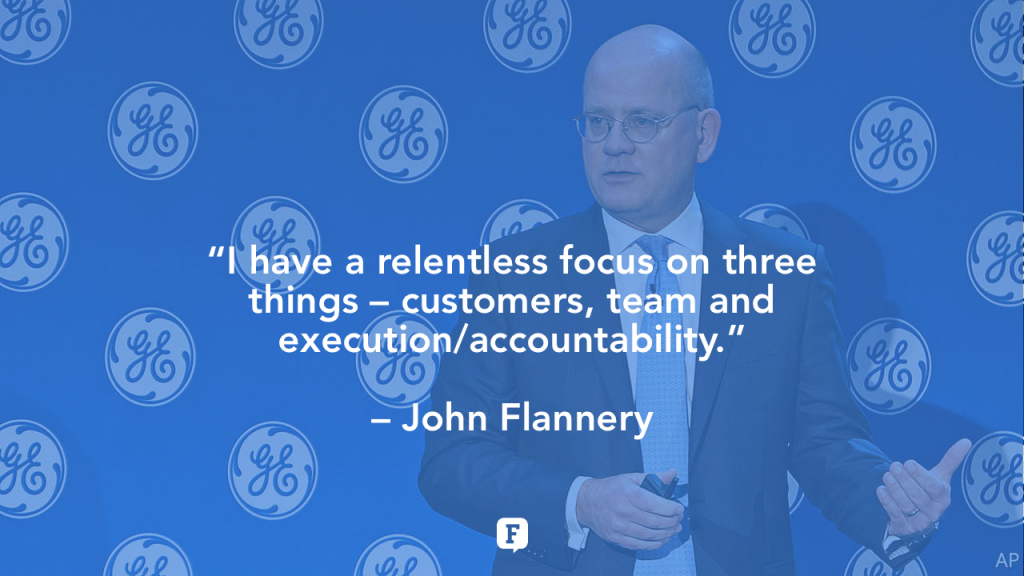
Photo courtesy of the Economist
When John took over the helm at General Electric, he made it abundantly clear to the company’s 300,000 employees what needs to be done and accomplished. In a letter to the team, he said:
I have a relentless focus on three things – customers, team and execution/accountability.
― John Flannery
If you’ll notice, Flannery didn’t highlight 10 or even 5 initiatives. John Flannery knows that people can only carry and pick up 3 or 4 key messages. The best way to get your team members to remember and follow things is to be precise and specific in what you want them to do. Giving and relaying too many action points and next steps often confuses your team and our cognitive understanding cannot process too many ideas at once. This is what researches refer to as “cognitive backlog”. The best way to solve this within your team is to foster the rule of 3. By boiling down everything into just 3 key points, you’ll avoid the fluff and just focus on what matters to people.
3. Sheryl Sandberg, COO of Facebook: Share Your Views In A Nonthreatening Way
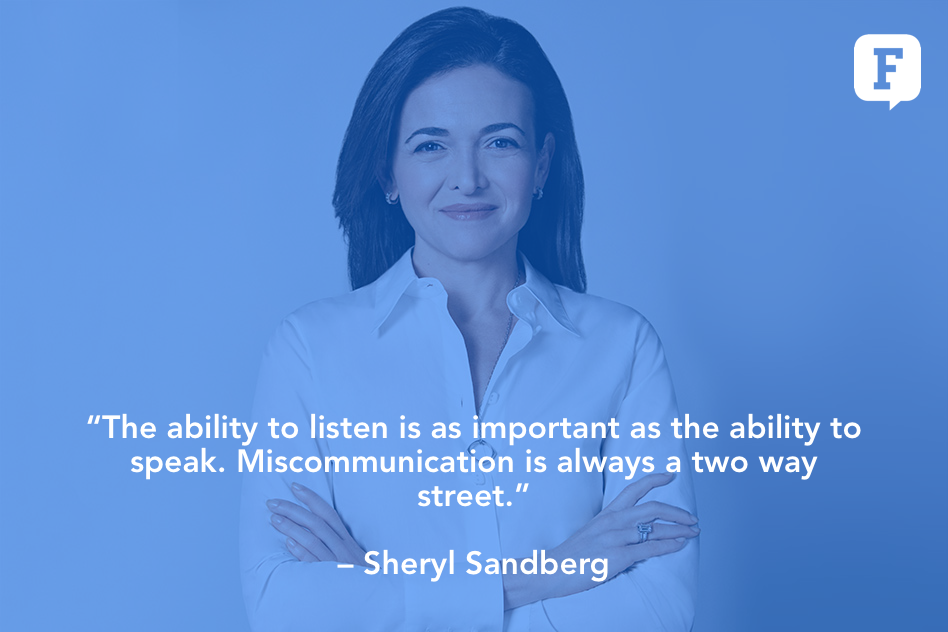
Photo courtesy of Facebook
Sheryl Sandberg is an exceptionally insightful leader. So it is not surprising she is also an excellent communicator. One of the key team communication strategies she shared in her book “Lean In: Women, Work, and the Will to Lead” reflects on how even in business, there’s rarely one absolute truth. Which is why we need to communicate our views in a nonthreatening way:
I learned that effective communication starts with the understanding that there is MY point of view, (my truth), and someone else’s point of view (his truth). Rarely is there one absolute truth, so people who believe that they speak THE truth are very silencing of others. When we realize and recognize that we can see things only from our own perspective, we can share our views in a nonthreatening way. Statements of opinion are always more constructive in the first person “I” form. The ability to listen is as important as the ability to speak. Miscommunication is always a two way street.
― Sheryl Sandberg
Sharing your views in a nonthreatening way is necessary so other people in the room wouldn’t feel put down, silenced. Even more, it shows that you listen and hear what others are saying as well. In this way, no one will feel discouraged from speaking up in the team, fostering the kind of team culture where effective team communication “just happens”.
4. Jack Stahl, Revlon CEO and Former President of Coca Cola: Provide Constructive Criticism Without Demoralizing
Stahl understood the importance of providing constructive feedback early on in his career. But he learned this not as a leader but as a member of the team. His observations on how his superiors would handle errors and failure became the cornerstone of his leadership style when he took over the position of President in Coca Cola. In an article for Harvard Business Review, he outlines the ways he manages to give effective feedback. One situation stands out the most. For a while, he was the lead project manager of taking a company public. His primary task was to develop a prospectus on the operations and finances of the company:
One evening about a month before the prospectus was due, my boss–then the CFO of the company–sat in with my team to review our progress. I thought everything was right on track, but he painstakingly pointed out that there were about 187 holes in the draft document: critical financial information that was still missing, even the phone number of the new company we were forming. We spoke about the need for me to be more focused on details and to follow up consistently with my direct reports to make sure things were getting done. At the end of the conversation, I was worrying about my own future. [But] He went out of his way to reassure me that my missteps weren’t fatal, that he still valued and supported me, It made me understand that when people feel valued, they can hear difficult feedback without being demoralized by it. Instead, they feel motivated to change.
― Jack Stahl
Feedback is necessary to make sure that mistakes are avoided again in the future and your team members understand what needs to change. Remember that constructive criticism should remain constructive. To make feedback more effective, make it clear to everyone in the team. Be detailed and concise on what needs to happen moving forward. At the same time, accept criticism as well. Effective team communication is about giving everyone the opportunity to speak out and give each other the tough love they need.
5. Sam Walton, Walmart Founder and CEO: Be Truthful and Honest to Your Team Members
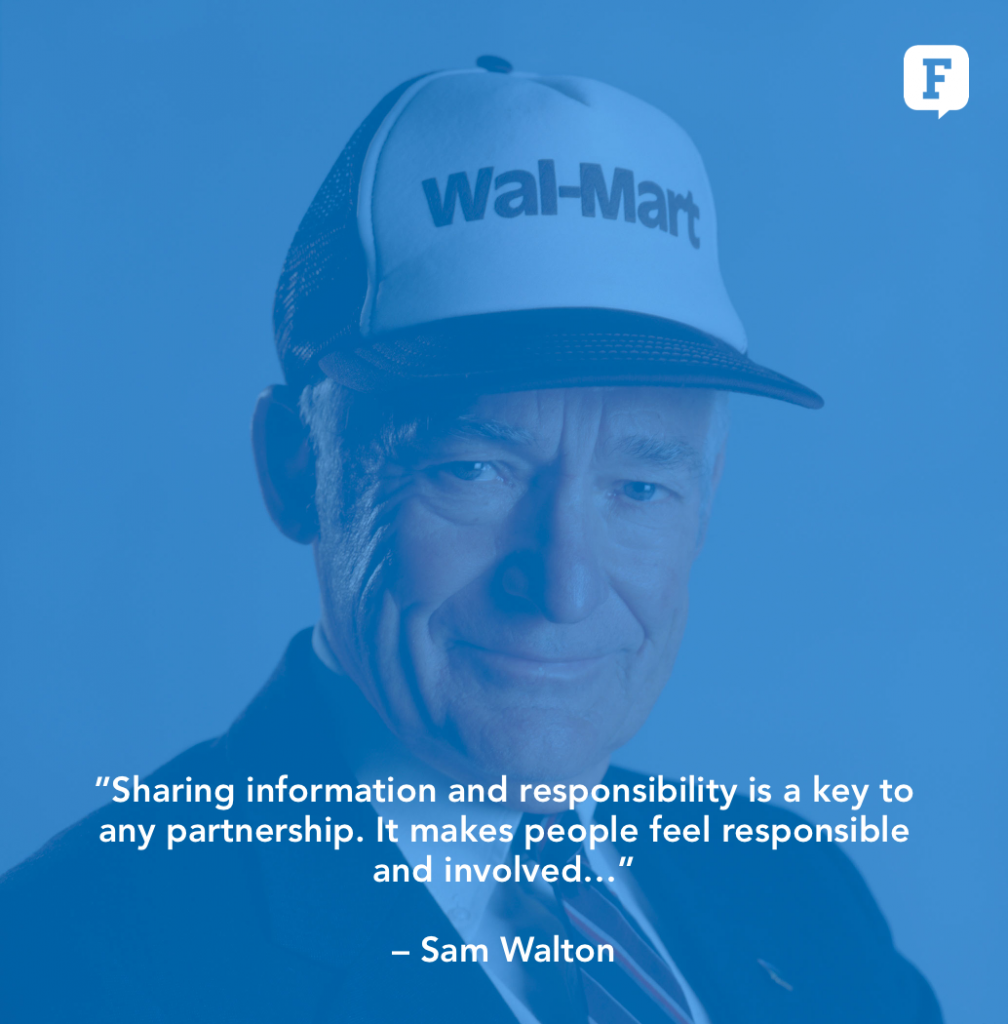
Photo: Louie Psihoyos/CORBIS
No one understands the value of being honest like Sam Walton, the head of retail giant Walmart. In his autobiography “Made in America” Walton explains how he believes that it’s important to treat team members like co-owners of the business. He does this by sharing a complete overview of the current status of the business or any project. He knows that by doing so, he will encourage them to suggest solutions to problems and discuss opportunities that can bring them growth:
Our very unusual willingness to share most of the numbers of our business with all the associates … It’s the only way they can possibly do their jobs to the best of their abilities—to know what’s going on in their business. … Sharing information and responsibility is a key to any partnership. It makes people feel responsible and involved …. In our individual stores, we show them their store’s profits, their store’s purchases, their store’s sales, and their store’s markdowns.
― Sam Walton
This is by far one of the most effective ways to bridge the communication gap in the workplace. Honesty builds trust in the team. The key here is to be as open and transparent as possible. Don’t make your employees feel like things are being hidden from them. While there will always be sensitive information you cannot divulge, it’s better to be clear why some information is not being shared. Give your employees the assurance that they can be honest with you without any pushback and ask if they would do the same thing to you. Mutual understanding and belief in one another can be beneficial to any professional relationship. The most effective managers and leaders know how to relate and understand their employees. This involves admitting to failure or lapse in judgement. Taking steps to owning up mistakes you have done can show that everyone is susceptible to mistakes and gives you a sense of humanity that your employees value.
6. Seth Godin, Top Author and Entrepreneur: Create an easy and relaxed environment

Photo by Joi Ito (Seth Godin) via Wikimedia Commons, CC BY 2.0
While achieving business goals is paramount to your success, smart business leaders understand that your team member’s personal convictions matter as well. Being able to inspire and make your employees feel confident about the decisions they are making can lead to less confrontations and more opportunities to discuss anything openly as needed. Seth Godin has always believed that leaders have the accountability to boost their employees’ regard for themselves and empower them to use their ideas:
Leadership is the art of giving people a platform for spreading ideas that work.
― Seth Godin
When aligned with the company’s spirit, personal goals and values enable people to do more. In keeping with this, it’s important to allow interactions within the workplace that foster this kind of alignment. Set informal meetings with your team members via coffee breaks or lunch outs. It has been shown by research that conversations over coffee or lunch promote healthy communication and encourage open discourse on ideas.
7. Jess Bezos, Amazon CEO: Disagree and Commit
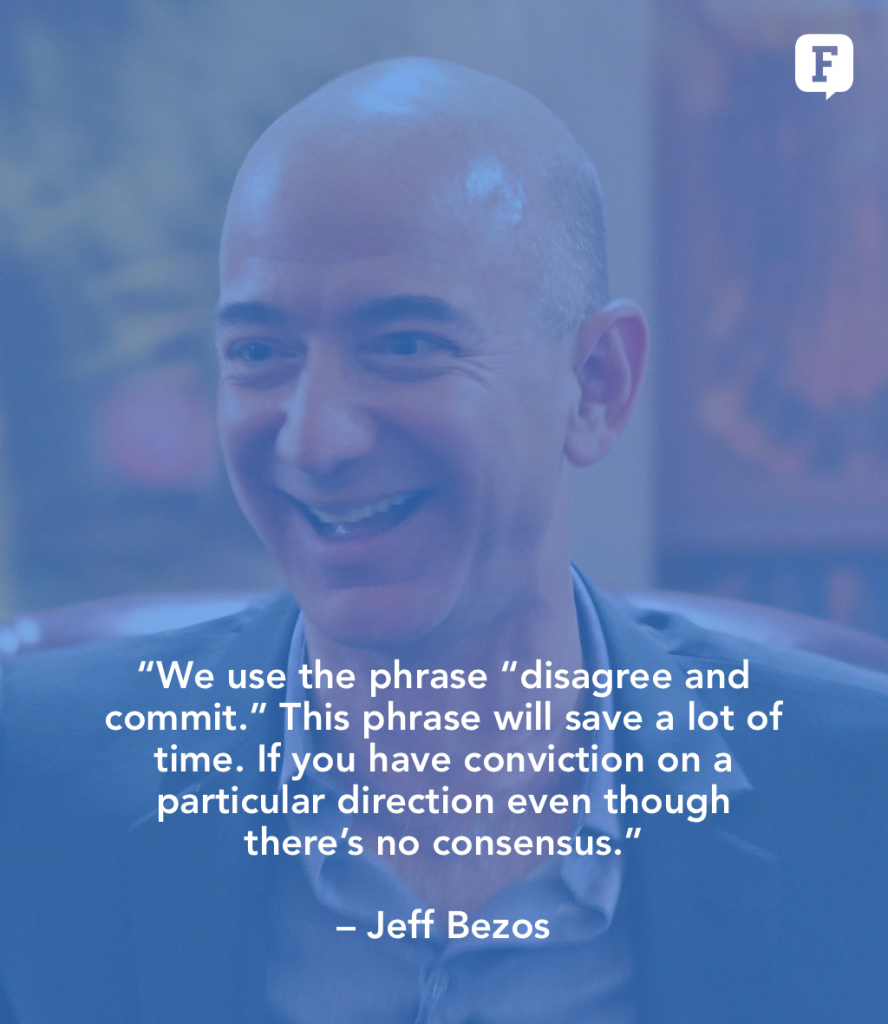
By: Steve Jurvetsonderivative work: King of Hearts via Wikimedia Commons, CC BY 2.0
Healthy discussion is the cornerstone of great team communication. It fosters and allows your team members the opportunity to air out violent reactions or responses to certain decisions that the team plans to take. It’s no secret that there are dissenting opinions across each and every one of us when it comes to how to attack a certain problem or issue. In order to get things done, you must be able align everyone in your team and keep them committed. Compromises are a part of this. Jeff Bezos has recognized the value of compromise, as he wrote to shareholders about disagreeing and committing last 2017:
We use the phrase “disagree and commit.” This phrase will save a lot of time. If you have conviction on a particular direction even though there’s no consensus, it’s helpful to say, “Look, I know we disagree on this but will you gamble with me on it? Disagree and commit?” By the time you’re at this point, no one can know the answer for sure, and you’ll probably get a quick yes. This isn’t one way. If you’re the boss, you should do this too. I disagree and commit all the time. We recently greenlit a particular Amazon Studios original. I told the team my view: debatable whether it would be interesting enough, complicated to produce, the business terms aren’t that good, and we have lots of other opportunities. They had a completely different opinion and wanted to go ahead. I wrote back right away with “I disagree and commit and hope it becomes the most watched thing we’ve ever made.” Consider how much slower this decision cycle would have been if the team had actually had to convince me rather than simply get my commitment.
― Jeff Bezos
Using this phrase actually cuts the time it takes for everyone to decide and curtail what would have been an endless back-and-forth. It’s also a way of showing support to everyone regardless of your own personal views.
“We use the phrase 'disagree and commit.' This phrase will save a lot of time.” – Jeff Bezos
8. Steve Jobs, Apple CEO: Build Your Team’s Communication Capabilities
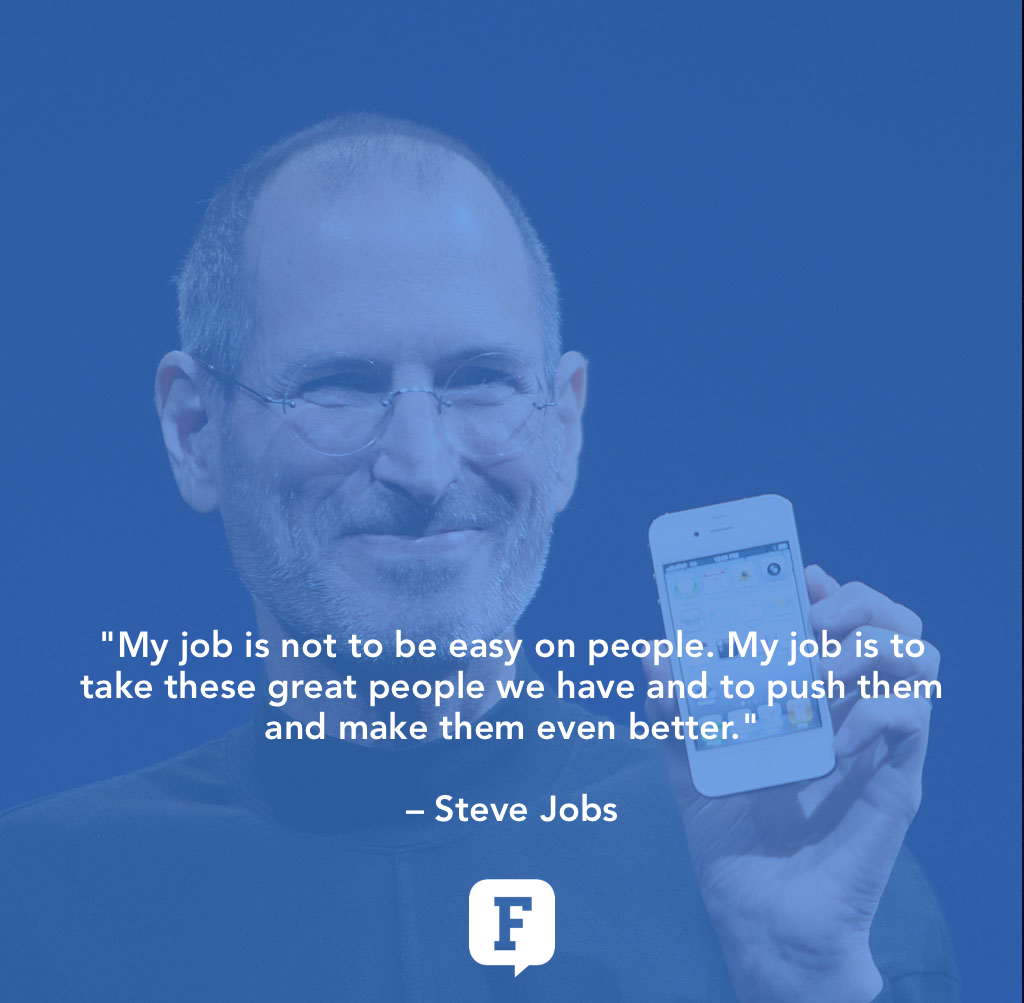
By Matthew Yohe via Wikimedia Commons, CC BY-SA 3.0
Taking workshops and lessons on communication can be great at improving your team’s capabilities. Even if you set the rules or implement a certain strategy, people may still go back to their old patterns. Having regular trainings will make your team more adept than ever before. Steve Jobs knew this well. The top tech CEO was known for being tough on his employees and team members but has always advocated that the role of a leader is to make them the best that they can be:
My job is not to be easy on people. My job is to take these great people we have and to push them and make them even better.
― Steve Jobs
Communication training doesn’t just underscore the way we converse and communicate with each other. It could also cover important skillsets that can improve your business, like presentation skills, business writing and team management. They can be quite expensive but the benefits can match it when you see your team communicating like clockwork.
At the same time, developing your team’s capabilities in communication is also about highlighting their key strengths. Each and every one of us communicates differently. There are people who would prefer emails to face-to-face meetings. Some would be more adept when they are done via auditory means like a phone call. Others via a personal chat message on a team chat platform like Fleep. Check and see which type of communication works well with your team members. Luckily, Fleep allows you to communicate with everyone regardless if they still want to keep using email, video call or messenger format.
9. Sophia Amoruso, Founder of Nasty Gal: Setting expectations and managing roles

Photo courtesy of Mend
Another effective way of communicating with your team is being clear on what is required from them and what are the roles that each one will do from the very beginning. If you communicate clearly what you need from your team and why, they have a clear direction on where to go. Girl boss Sophia Amoruso captures this well:
Communication is really important. Being proactive with communicating out, but also creating an expectation that your team will communicate back, and making it clear how that should happen. Explaining not just what you want to do, but why you want to do it is really important, because people want meaning.
― Sophia Amoruso
I’ll bet that no one will finish a project or do their work on time if the tasks that are given to them are not clear. Ensure that the entire team understands their scope of work. Round-up the team each week to check on their status reports, ask the right questions and address any concerns they may have. Make them aware of their responsibilities.
“Team Communication Strategies: How Top CEOs and Leaders Communicate With Their Team” on the Fleep Blog
Designing Your Own Team Communication Strategy
There you have it! You’ve finally discovered some of the tips and tricks that top CEOs and business mavericks use when they engage with their team members. While these strategies are helpful, it’s equally important to set your own course. As I’ve said earlier, every team is unique and so your team will work differently than others. You are the only one who can bet which strategy will work for you. So, here are some practical tips for developing your own team communication strategy:
- Decide on the best channels for team communication
It’s probably smart to choose a tool that is meant for team communications, and leave phone calls for urgent matters, consumer apps for personal life. So you may consider using a team chat app, like Fleep. Unlike other team chat applications, Fleep is an open network and integrates well with email. It’s a vast open network that allows you to contact anyone, anywhere regardless of what device they have! You can also give out tasks – being clear on everyone’s job and pin important messages that they need to remember. You can even work and organize your contacts into project teams for easier collaboration and discussion. It gives you and your team members the power to make communication easier and less stressful. - Manage expectations with rules and guidelines
Once the team is prepped and the chat is up and running, it’s time to set some ground rules. This helps manage expectations for communication, like whether people have to respond quickly or if asynchronous communication works better. Or when and how often the team would need to meet. You may also want to set the tone for your team with some guidelines of participation – allowing ideas to run through brainstorming without passing judgement or ensuring that no one interrupts when another person is speaking etc. All of the rules should be agreed on by everyone. - Determine roles
Have everyone agree on their roles and responsibilities. Be clear on the designations and who have decision making power. In this way, everyone knows what is expected of them – and whenever there is a disagreement, it is clear who has the right and responsibility to call the shots. - Have a system for resolve communication issues
When communication issues rise (as they most certainly will), strive to address them immediately. Have the team leader or other decision-maker serve as the mediator. The first step in addressing such issues is to evaluate if any rule has been broken. Be clear on what your system is for resolving issues, and make sure everyone involved in the issue comes to an amicable resolution.
Takeaways
Taking advantage of these tips can help align your team’s goals and improve communication across all levels of your organization. It creates a stress-free environment that is helpful to the success of the project as whole. Communication is always made easy by being open, honest and transparent with one another. Using the right tools, like Fleep, that allow for transparency in the team is great for that too. Treat your team members like family and they are bound to do the same for you.
Want to communicate with your team easily? Sign up for Fleep now!
Further Reading:


